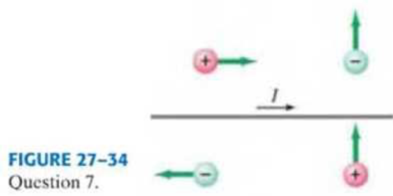
Concept explainers
In Fig. 27–34, charged particles move in the vicinity of a current-carrying wire. For each charged particle, the arrow indicates the direction of motion of the particle, and the + or – indicates the sign of the charge. For each of the particles, indicate the direction of the magnetic force due to the magnetic field produced by the wire.

Want to see the full answer?
Check out a sample textbook solution
Chapter 27 Solutions
Modified Mastering Physics without Pearson eText-- Instant Access -- for Physics for Scientists & Engineers with Modern Physics
Additional Science Textbook Solutions
Chemistry: Structure and Properties (2nd Edition)
Introductory Chemistry (6th Edition)
Anatomy & Physiology (6th Edition)
Applications and Investigations in Earth Science (9th Edition)
Organic Chemistry (8th Edition)
Physics for Scientists and Engineers: A Strategic Approach, Vol. 1 (Chs 1-21) (4th Edition)
- Steel train rails are laid in 13.0-m-long segments placed end to end. The rails are laid on a winter day when their temperature is -6.0° C. Part A How much space must be left between adjacent rails if they are just to touch on a summer day when their temperature is 32.0°C? Express your answer with the appropriate units. ☐ о μΑ ? D = Value Units Submit Previous Answers Request Answer × Incorrect; Try Again; 3 attempts remaining Al Study Tools Looking for some guidance? Let's work through a few related practice questions before you go back to the real thing. This won't impact your score, so stop at anytime and ask for clarification whenever you need it. Ready to give it a try? Start Part B If the rails are originally laid in contact, what is the stress in them on a summer day when their temperature is 32.0°C? Express your answer in pascals. Enter positive value if the stress is tensile and negative value if the stress is compressive. F A Ο ΑΣΦ ? Раarrow_forwardhelp me with this and the step I am so confused. It should look something like the figure i shownarrow_forwardPart A In an effort to stay awake for an all-night study session, a student makes a cup of coffee by first placing a 200 W electric immersion heater in 0.250 kg of water. How much heat must be added to the water to raise its temperature from 20.5° C to 95.0°C? Express your answer in joules. ΕΠΙ ΑΣΦ Q Submit Request Answer Part B ? J How much time is required? Assume that all of the heater's power goes into heating the water. Express your answer in seconds. VG ΑΣΦ ? t = Sarrow_forward
- help i dont understand this it should look like something like this picture. help me with the stepsarrow_forwardDraw the velocity vectors starting at the black dots and the acceleration vectors including those equal to zero.arrow_forwardYou toss a ball straight up by giving it an initial upward velocity of 18 m/s. What is the velocity of the ball 0.50 s after you released it? Define the positive y direction to be upward, the direction that you toss the ball.arrow_forward
- 10:44 AM Fri Jan 31 O Better endurance Limb end points travel less D Question 2 Take Quiz 1 pt: Two springs are arranged in series, and the whole arrangement is pulled a vertical distance of 2 cm. If the force in Spring A is 10 N, what is the force in Spring B as a result of the displacement? 05N 5 N 0.2 N 10 N O2N Question 3 1 ptsarrow_forwardNo chatgpt pls will upvote Already got wrong chatgptarrow_forwardPlz no chatgpt pls will upvotearrow_forward

 Physics for Scientists and Engineers: Foundations...PhysicsISBN:9781133939146Author:Katz, Debora M.Publisher:Cengage Learning
Physics for Scientists and Engineers: Foundations...PhysicsISBN:9781133939146Author:Katz, Debora M.Publisher:Cengage Learning Principles of Physics: A Calculus-Based TextPhysicsISBN:9781133104261Author:Raymond A. Serway, John W. JewettPublisher:Cengage Learning
Principles of Physics: A Calculus-Based TextPhysicsISBN:9781133104261Author:Raymond A. Serway, John W. JewettPublisher:Cengage Learning College PhysicsPhysicsISBN:9781305952300Author:Raymond A. Serway, Chris VuillePublisher:Cengage Learning
College PhysicsPhysicsISBN:9781305952300Author:Raymond A. Serway, Chris VuillePublisher:Cengage Learning College PhysicsPhysicsISBN:9781285737027Author:Raymond A. Serway, Chris VuillePublisher:Cengage Learning
College PhysicsPhysicsISBN:9781285737027Author:Raymond A. Serway, Chris VuillePublisher:Cengage Learning Glencoe Physics: Principles and Problems, Student...PhysicsISBN:9780078807213Author:Paul W. ZitzewitzPublisher:Glencoe/McGraw-Hill
Glencoe Physics: Principles and Problems, Student...PhysicsISBN:9780078807213Author:Paul W. ZitzewitzPublisher:Glencoe/McGraw-Hill





